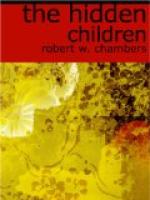I understood this more clearly now, as I lay watching the proceedings, for I had seen this feast in company with Guy Johnson on the Kennyetto, and found in it nothing offensive and no revolting license or blasphemy, though others may say this is not true.
Yet, how can a rite which begins with three days religious services, including confession of sins on wampum, be otherwise than decent? As for the rest of the feast, the horse-play, skylarking, dancing, guessing contests— the little children’s dance on the tenth day, the Dance for Four on the eleventh, the Dance for the Eight Thunders on the thirteenth— the noisy, violent, but innocent romping of the False Faces— all this I had seen in the East, and found no evil in it and no debauchery.
But what was now already going on I had never seen at any Iroquois feast or rite, and what Amochol had made of this festival I dared not conjecture as I gazed at the Dreamers now advancing into the circle with an abandon and an effrontery scarcely decent.
Six young girls came first, naked except for a breadth of fawn-skin falling from waist to instep. Their bodies were painted vermilion from brow to ankle; they carried in their hands red harvest apples, which they tossed one to another as they move lightly across the open space in a slow, springy, yet not ungraceful dance.
Behind them came a slim maid, wearing only a black fox-head, and the soft pelt dangling from her belt, and the tail behind. She was painted a ruddy yellow everywhere except a broad line of white in front, like a fox’s belly; and, like a fox, too, her feet and hands were painted black.
Following her came eight girls plumed in spotless white and clothed only in white feathers— aping the Thunders, doubtless; but even to me, a white man and a Christian, it was a sinister and evil sight to see this mockery as they danced forward, arms entwined, and the snowy plumes floating out in the firelight, disclosing the white painted bodies which the firelight tinted with rose and amber lights.
Then came dancing other girls, dressed in most offensive mockery of the harmless and ancient rite— first the Fire Keeper, crowned with oak leaves instead of wild cherry, and wearing a sewed garment made of oak twigs and tufted leaves, from which the acorns hung. Followed two girls in cloaks of shimmering pine-needles, and wearing wooden masks, dragging after them the carcasses of two white dogs, to “Clothe the Moon Witch!” they cried to the burly Erie acolyte who followed them, his heavy knife shining in his hand.
Then the Erie disemboweled the strangled dogs, cast their entrails into the fire, and kicked aside the carcasses, shouting:
“Atensi stands naked upon the Moon! What shall she wear to cover her?”
“The soft hide of a Hidden Child!” answered a Sachem from behind the altar. “We have so dreamed it.”
“It shall be done!” cried the Erie; and, lifting himself on tip toe, he threw back his brutal head and gave the Panther Cry so that his voice rang hideously through the night.




